Tuesday, May 2nd 2006
Arrived at Xi'An around 10am, and was greeted by our lovely tour guide...(I forgot her name) holding a sign and a yellow flag. I had forgotten that Ren had arranged for a guide and a private van for the next three days. I was disappointed that we didn't get matching yellow hats like the other tourists. Not.
Brief history of Xi'An (DK guide): Capital of modern Shaanxi, Xi'an has served as capital to 11 dynasties over a period of 4,000 years, including the Western Zhou, Western Han, Qin, Western Wei, Northern Zhou, Sui and Tang. The Chinese trace its lineage back even further to the mythical Yellow Emperor, who made Xianyang his capital (2200-1700 BC). Xi'an peaked during the Tang dynasty, when its position at the eastern end of the Silk Road transformed it into a bustling metropolis, luring foreign merchants and faiths, including Nestorian Christians, Muslims, Zoroastrians, Manicheans, and Buddhists. The city declined later but has some splendid sights and thriving touring economy.
As soon as we left the airport, we were shuttled from one tourist attraction to another. I had no idea we were on a sight seeing mission. My brain has been on leave for what, 5 months? And all of a sudden I'm cramming all this historical information in it. Oh, and of course the same rules apply here as well - you can't get anywhere or see anything interesting without having to CLIMB something ...and beware of the loos.
Tip: Best to get a local tour guide when visiting Xi'An. It will make your trip much more enjoyable and organized. You can also get an English speaking guide but the fees are much higher. The trip cost around USD 500/per person, including plane tickets, accommodation for 4 nights, sight seeing tickets, food, tour guide fees and van rental. Things are very much cheaper in Xi'an in comparison to other cities. The food portions can be rather large at times.
Xi'an City Walls
Our first stop was the Old City Walls. It's a 9-mile long wall built in 1390 under the reign of the first Ming Emperor, Hongwu, on the foundations of the Tang imperial palace. The walls are still intact and now circle the city center of Xi'An. Interesting fact: according to the DK guide, these walls were built using rammed earth, quicklime and glutinous rice extract. And yet, after 616 years it still surviving. I hope the leaders of the ever growing construction industry in our times are taking notes.


Drum beating; that's Ren on my left.



Weapons used to attack enemies from the towers

We were given a feng shui tour; the guide reminded me of Jai from The Fab Five, except he's Chinese. They had photos of buildings around the world with the best and the worst feng shui. Jim and Erika: I wish you were here.
Forest of Stelae Museum
Otherwise known as the Handwriting Park.
After our feng shui tour at the Old City Walls, we were shuttled here. To see stone pillars. And tablets. Many tablets. Many, MANY of them. After the first 10 minutes, I lost interest. Hey, at least I'm admitting it. I blame it on hunger and the lack of sleep from the night before.
Anyway, this "Handwriting Park" is where the Chinese Masters used to teach. Also, you will find religious artifacts, tablets, historical records (of Buddhism, Christianity, etc.) dated back to their early discoveries. For historians, there are reference materials on the local history and society during the Song, Yuan, Ming and Qing eras.


Notice the three entrance doors in the picture on the right? A lot of the palaces, parks, etc. have the same design. The center door is reserved, or used to be reserved, for emperors and officials of higher ranks, and the side doors for people like you and me.
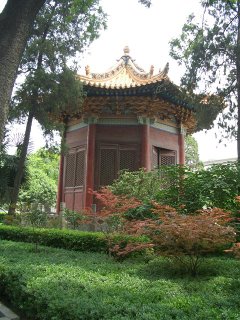
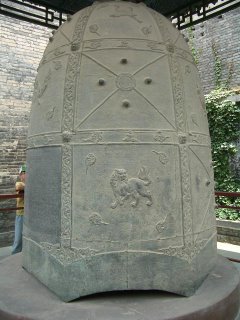
A Jingyun bell in Tang - the bell was cast in 711AD during the Tang dynasty. Weighs about 6 tonnes, and is engraved with inscriptions and adorned with the images of lion, phoenix, dragon, etc. The contents of the inscription tells of the mystery and abstruseness of taoism and some words of praise of the bell.


Tablets.




Thought the details of the steps were pretty interesting; these small pillar-like things with different designs at the top were used for tying horse ropes; tablet designs




Buddha artifact; one of the 6 famous horses; a prince's tomb; tomb door
Okay, so Vic - this one's for you:
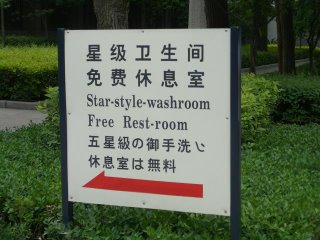
The sign reads "STAR-STYLE WASHROOM"
Toilets
What's with the toilets? For starters, here's what the DK guide has to say (although I would recommend getting the Lonely Planet guide for a better version):
Public Bathrooms
Public bathrooms are typically of the squat variety and are squalid, filthy and rarely cleaned, unless watched over by an attendant. There is little privacy - doorless cubicles, separated by low walls, are the norm. Toilet paper is a rarity - don't forget to carry your own supply. Toilet paper should be put in the receptacle, if provided, rather than down the toilet, as septic systems are often unable to handle paper products. You will be expected to pay a few jiao for using the facilities. Use hotel and fast-food restaurant bathrooms whenever you get the opportunity.
Get it?
On my second day in Beijing, I was already rating the toilets. So far, I haven't had to use anything lower than 2 stars. If you think restaurant toilets are cleaner, you are wrong (unless of course you go to an upper class restaurant). Having said that, the toilets in Beijing are quite alright. I haven't had to use a doorless cubicle at all the entire trip. My mum went 12 years ago, and she said people had their umbrellas open to cover the sight of their posterior. Lanna was proud to show me the Grand Hyatt hotel toilets in Beijing which she visits ever so often when she goes to town. Someday they will have a photo of her in front of the doors with a no entry sign across it.
The toilet situation in Xi'an is a whole different story. It's an old city, generally dirty and not as developed as Beijing. I've never been on a trip where I had to watch how much liquid I consumed before. Pretty pathetic really. I've managed to avoid using public toilets as much as possible. Also, it would probably be wiser to use those at tourist attractions. Lanna heard a rumour that the toilets in McDonalds are actually quite clean. At least the golden arches is worth a visit in China.
Lunch!
Finally at 2ish, we were off to get some lunch. Xi'an is mainly populated by Chinese Muslims, hence, you will find men in white hats everywhere and also the lack of pork dishes (Chinese love pork). Instead, this a city that's famous for it's lamb specialties.
We had lamb noodles. They give you this huge bowl of soup with veg and lamb and a basket with slices of bread - hard bread I might add. What you're supposed to do is tear the bread into small pieces and throw them into the soup. So, I took 1/4 of a slice and did what I was told. When I was done, everyone was looking at me. How am I supposed to know each of us got an entire piece of hard bread that's the size of my face?
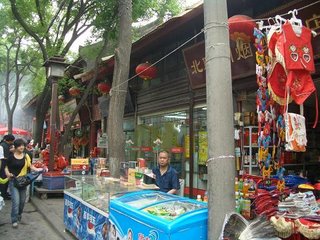


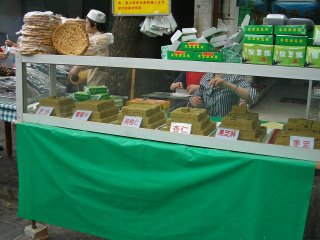
I don't actually know the name of this street, but it is THE street to go to for food and souvenir shopping.


This young lady is selling some kind of multi-coloured dessert. Ren said, "Just look, don't eat."; hand made slippers and bags
Shaanxi History Museum
Off to Shaanxi History Museum after lunch. Since my travel blogs are beginning to become annoying long, I will try to be brief when inserting a description of a place. Click on the link and read about it yourself. :)
The Shaanxi Museum is pretty big, and house approximately 400,000 relics which chronicles the Shaanxi civilization and culture. Some of the articles found here date back to prehistoric times. My favourite part was browsing thru everyday kitchen items like kettles, decanters, plates, etc. Perhaps Crate and Barrel should consider adding an Oriental section to their collection.
One architectural note: You will notice a lot of the buildings here are built in grey or black and white tones. These are distinctively from the Tang dynasty. The colourful structures that we've seen in Beijing, with gold, red, green and whatnot were prior to the Tang dynasty.


The museum buildings
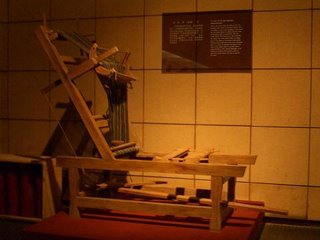

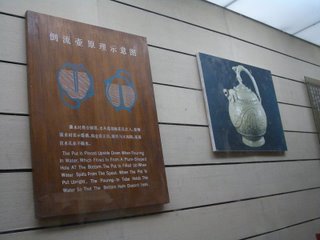
Loom; a model of the chariot used by Shih Huang Ti (we will see the real one at the terracotta tomb tomorrow); very cool teapot - you pour the water in upside down thru a plum-shaped hole at the bottom. The pot is filled when water spills from the spout. When the pot is put upright, the pouring in tube holds the water so it doesn't leak from the hole at the bottom.

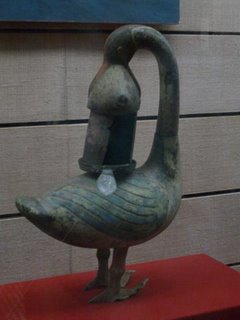

The one thing that all women must love about the Tang dynasty is this: Just like women in the Middle Ages and the Renaissance, plumpness was the epitome of beauty. History tells us that Yang Kwei Fei, the most beloved and beautiful concubine of the Tang Emperor was plump. You know the rest of the story. All the women depicted in paintings, pottery, murals, etc... of the Tang dynasty are plump. 2nd picture - some kind of decanter; first form of paper

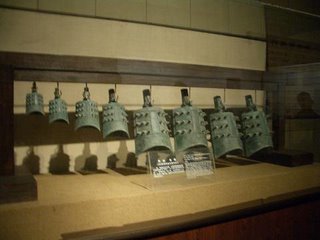

Zhou Wine Decanter; musical instrument; pottery figures
The Great Goose Pagoda
If all that wasn't enough to tire us, we still had one more place to go before checking into our hotel. The Great Goose Pagoda, also known as the Dayan Ta. Why goose? I don't know. If you want to see a pagoda, go to Xi'an. Seems like they are everywhere.

Built in memory of Empress Wende, Dayan Ta has exhibitions on pagoda designs and history, a large temple complex and several halls that contain statues of Buddha


People lighting candles and joss sticks
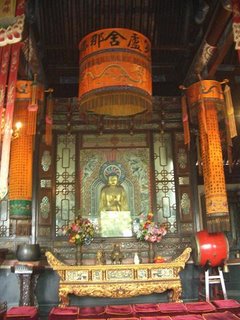
Main temple complex
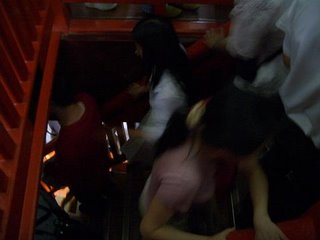

Of course we had to climb to the top. It's the trend. It was packed and then there was the tiny staircase. I felt a sense of deja vu. It was like climbing the Wallace National Monument in Stirling again - except that was much higher. Anyhow we got our reward in the end - a nice view of the city of Xi'an.

We checked in at the hotel at 7pm and left for dinner at 7:30pm. At this point, I could've eaten a cow. We had some muslim food which was pretty tasty.
I will have to write about the water situation in the hotel in my next post.
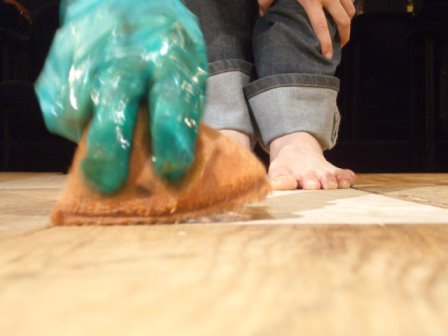
1 comment:
This is a really good read for me, Must admit that you are one of the best bloggers I ever saw.Thanks for posting this informative article.
Post a Comment